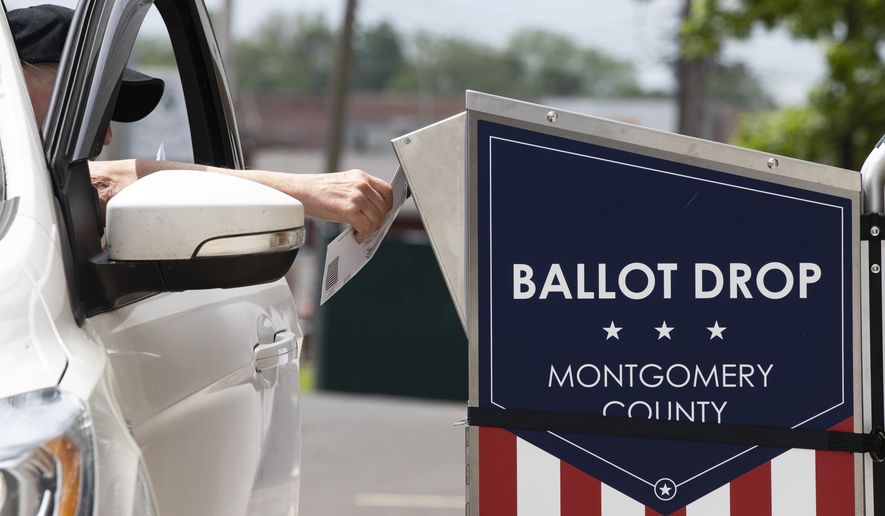
Mailed-in votes often wind up missing in action
by THE WASHINGTON TIMESANALYSIS/OPINION:
The coronavirus has been a killer of the conventional. Even as health dangers diminish, pressure is building for a radical shift in long-standing custom for the way the nation elects its leaders. Vote-by-mail may be a common-sense method of avoiding the risk of infection amid busy polling stations for the most vulnerable, but staking the outcome of the 2020 presidential election on postal proficiency is reckless.
Mail-in voting is an existing practice in a handful of states, and absentee voting is available in all 50, but not every outgoing ballot finds its way back to be counted. Of 146.3 million ballots mailed out between the 2012 and 2018 election cycles, tens of millions went missing, according to research published in April by the Public Interest Legal Foundation, an election integrity organization. “Putting the election in the hands of the United States Postal Service would be a catastrophe. Over the recent decade, there were 28 million missing and misdirected ballots,” PILF President and General Counsel J. Christian Adams wrote in an accompanying statement. “These represent 28 million opportunities for someone to cheat.”
Using data supplied by the U.S. Election Assistance Commission, the foundation found that among the avalanche of ballots mailed out, 2.1 million were sent to the wrong address and returned as “undeliverable,” and nearly 1.3 million were returned but rejected by election authorities. Among reasons for rejection are signatures that do not match those on file — a potential sign of fraud.
The 2018 midterm elections produced the largest number of uncountable votes: Of 42.4 million ballots dropped into the mail, almost 10.5 million were never completed and returned, more than a half-million were undeliverable, and another 430,000 were completed but rejected.
Vote-by-mail dispenses with the necessity for citizens to show up in person and, heaven forfend, identify themselves. No need to wait in line while properly spaced and tightly masked. A mailed ballot can be completed in the comfort of home by the recipient, or any ne’er-do-well who get his mitts on it.
President Trump sees mail-in voting as fraught with opportunities for mischief: “There is NO WAY (ZERO!) that Mail-In Ballots will be anything less than substantially fraudulent,” he tweeted Tuesday. “Mail boxes will be robbed, ballots will be forged & even illegally printed out & fraudulently signed.”
Twitter has taken the unprecedented step of labeling the president’s tweet “potentially misleading,” but there is little doubt that adding to the millions of missing ballots increases the risk of election devilry.
The U.S. Postal Service has a reputation that is envied by few, but it’s not the postman’s fault if election officials send their materials to inactive addresses, or if citizens requesting ballots by mail don’t bother to complete and return them. Many more millions of valid ballots can be expected to disappear if Americans are sufficiently spooked by disease into allowing the flawed mail-in ballot system to proliferate.
The fear factor is already having an impact. Eleven states have added concern over COVID-19 as a reason to request an absentee ballot, according to a Washington Post survey, and another 12 plus the District of Columbia have decided to seize the initiative and send absentee ballot applications to all voters. New Jersey, Nevada, Maryland and Montana are skipping the request procedure altogether and simply mailing out primary absentee ballots. Going further, California Gov. Gavin Newsom, a Democrat, has decided on his own authority that the general election in November will be conducted with mail-in ballots, prompting a lawsuit from fraud-fearing state Republicans.
If eight states and the District that are slated to hold primaries on June 2 encounter significant coronavirus-related difficulties at polling places, the trend toward vote-by-mail is likely to accelerate. Democrats on Capitol Hill want to fuel the movement with $3.6 billion in election funds as part of their $3 trillion coronavirus relief bill they presented last week. With the presidential election still more than five months away, their vote-by-mail demands appear more a response to political opportunity than virus necessity.
Americans vulnerable to the ravages of the contagion due to advanced age or health-related perils deserve a chance to avoid intermingling on Election Day and vote by mail instead. Other citizens without cause to vote absentee should support the integrity of the election system by voting the old-fashioned way: casting a ballot in person.